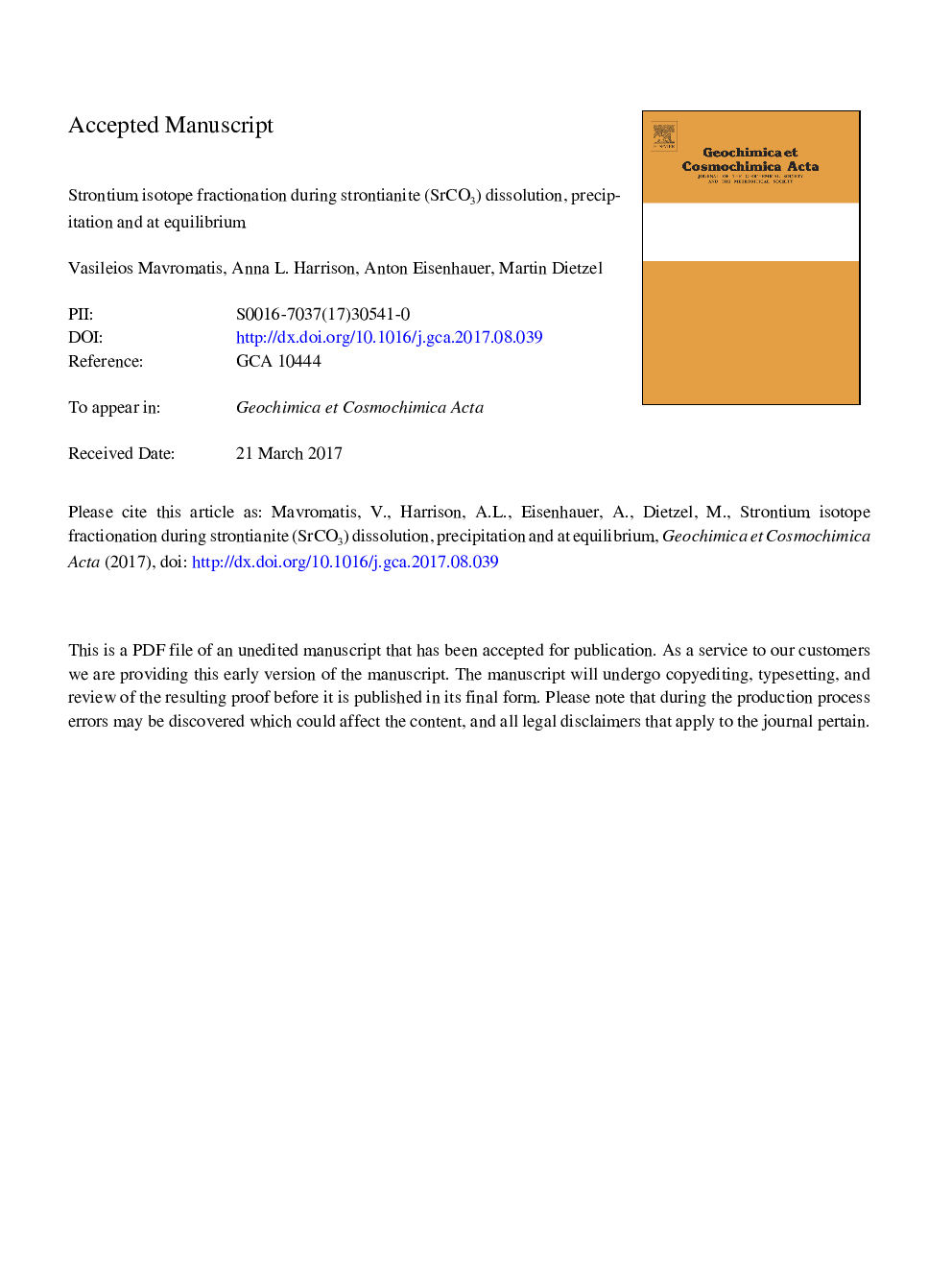| کد مقاله | کد نشریه | سال انتشار | مقاله انگلیسی | نسخه تمام متن |
|---|---|---|---|---|
| 5783306 | 1637939 | 2017 | 43 صفحه PDF | دانلود رایگان |
عنوان انگلیسی مقاله ISI
Strontium isotope fractionation during strontianite (SrCO3) dissolution, precipitation and at equilibrium
دانلود مقاله + سفارش ترجمه
دانلود مقاله ISI انگلیسی
رایگان برای ایرانیان
موضوعات مرتبط
مهندسی و علوم پایه
علوم زمین و سیارات
ژئوشیمی و پترولوژی
پیش نمایش صفحه اول مقاله

چکیده انگلیسی
In this study we examine the behavior of stable Sr isotopes between strontianite [SrCO3] and reactive fluid during mineral dissolution, precipitation, and at chemical equilibrium. Experiments were performed in batch reactors at 25 °C in 0.01 M NaCl solutions wherein the pH was adjusted by bubbling of a water saturated gas phase of pure CO2 or atmospheric air. The equilibrium Sr isotope fractionation between strontianite and fluid after dissolution of the solid under 1 atm CO2 atmosphere was estimated as Î88/86SrSrCO3-fluid = δ88/86Sr SrCO3 â δ88/86Srfluid = â0.05 ± 0.01â°. On the other hand, during strontianite precipitation, an enrichment of the fluid phase in 88Sr, the heavy isotopomer, was observed. The evolution of the δ88/86Srfluid during strontianite precipitation can be modeled using a Rayleigh distillation approach and the estimated, kinetically driven, fractionation factor αSrCO3-fluid between solid and fluid is calculated to be 0.99985 ± 0.00003 corresponding to Î88/86SrSrCO3-fluid = â0.15â°. The obtained results further support that under chemical equilibrium conditions between solid and fluid a continuous exchange of isotopes occurs until the system approaches isotopic equilibrium. This isotopic exchange is not limited to the outer surface layer of the strontianite crystal, but extends to â¼7-8 unit cells below the crystal surface. The behavior of Sr isotopes in this study is in excellent agreement with the concept of dynamic equilibrium and it suggests that the time needed for achievement of chemical equilibrium is generally shorter compared to that for isotopic equilibrium. Thus it is suggested that in natural Sr-bearing carbonates an isotopic change may still occur close to thermodynamic equilibrium, despite no observable change in aqueous elemental concentrations. As such, a secondary and ongoing change of Sr isotope signals in carbonate minerals caused by isotopic re-equilibration with fluids has to be considered in order to use Sr isotopes as environmental proxies in aquatic environments.
ناشر
Database: Elsevier - ScienceDirect (ساینس دایرکت)
Journal: Geochimica et Cosmochimica Acta - Volume 218, 1 December 2017, Pages 201-214
Journal: Geochimica et Cosmochimica Acta - Volume 218, 1 December 2017, Pages 201-214
نویسندگان
Vasileios Mavromatis, Anna L. Harrison, Anton Eisenhauer, Martin Dietzel,